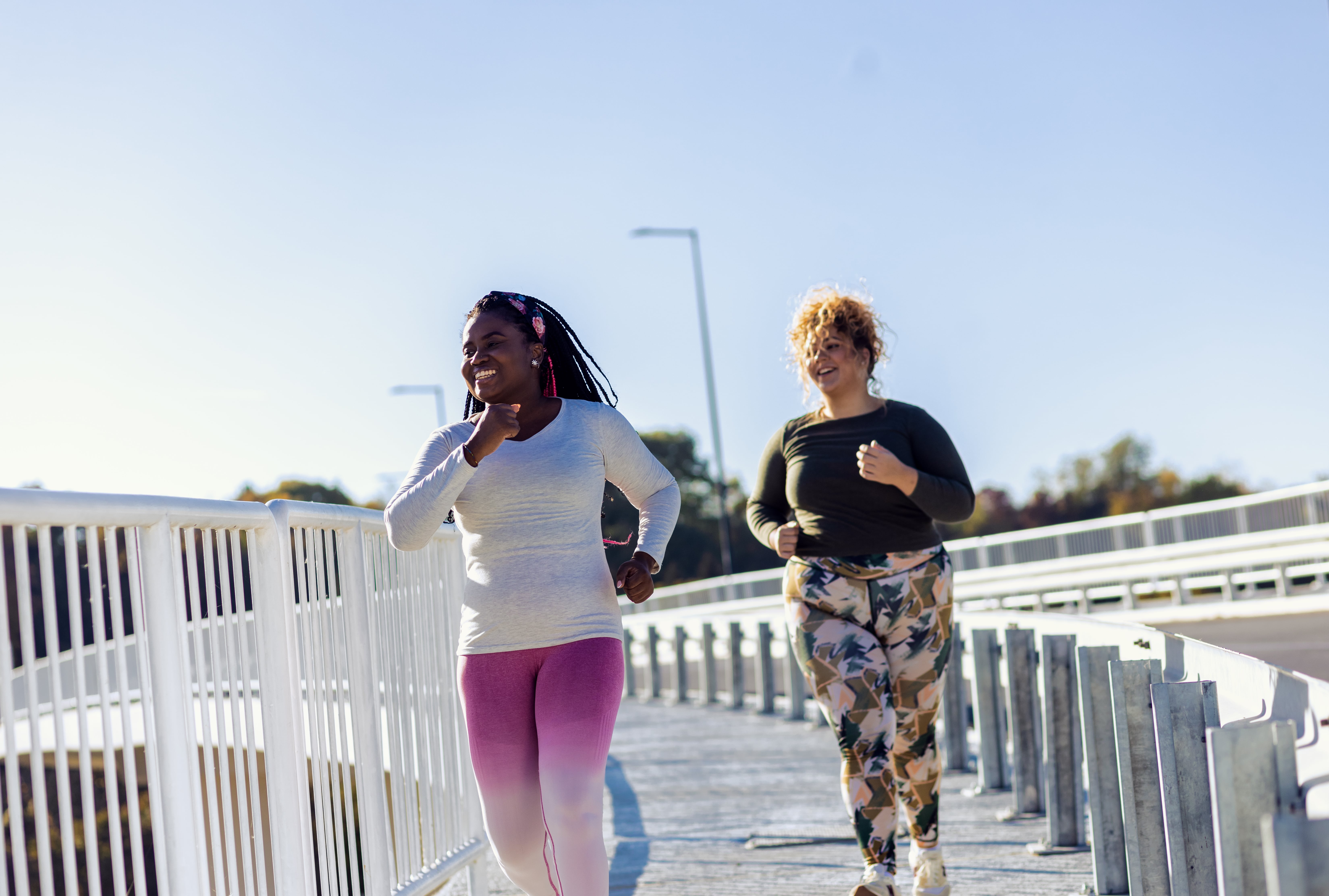Key Takeaways
- The 10,000-step goal originated from a marketing campaign, and recent scientific research shows significant health benefits are achievable at just 7,000 to 8,000 steps per day.
- While step count is a useful metric, it's not a perfect measure of fitness. Factors like intensity, consistency, and variety of workouts are crucial for a well-rounded approach to health.
- The most effective strategy is to use your step count as a tool to build a consistent habit of daily movement. Prioritize an enjoyable, sustainable routine over rigidly chasing a specific daily number.
{{mid-cta}}
Somewhere along the way, 10,000 steps became gospel. Smartwatches buzz at you, fitness apps push it, and people pace around their kitchens at 11:45 pm just to “close the ring.”
But here’s the thing: 10,000 was never science. It was marketing. Back in 1965, a Japanese company launched a pedometer called Manpo-kei, literally “10,000-step meter.”1,2 The number stuck because the Japanese symbol for 10,000 looks like a person walking.1,2 Clever branding, not clinical research.
Fast-forward to today, and the 10k rule is still everywhere. But does it actually mean anything for your health, fitness, or weight goals? Let’s look at what the science says, and where it doesn’t.
What the Science Really Shows

Here’s the good news: walking more is linked to better health outcomes, period. The data is clear. People who consistently rack up higher daily step counts have a lower risk of early death, cardiovascular disease, dementia, and even some cancers.3
But here’s the twist: the benefits don’t magically unlock at 10,000 steps. The science shows the payoff starts much earlier:
- 7,000–8,000 steps/day: Adults under 60 who hit this range see a massive drop, up to 50–70% lower risk of premature death.4,5,6
- ~4,500 steps/day: For older adults, the threshold is even lower. Just crossing into this zone is associated with strong protective effects against cardiovascular disease and overall mortality.4
- Every extra 1,000 steps: A 2020 study found that each additional thousand steps per day nudges risk down further, meaning the gains aren’t all-or-nothing.7
So what does this mean for you? You don’t need to chase the perfect 10k badge to make a serious impact. Movement at any level pays off, and the gains compound as you go. Even modest increases deliver outsized returns when you stack them day after day.
The takeaway: don’t obsess over a marketing-driven number. Instead, focus on progress. If you’re averaging 3,000 steps a day, bumping it to 4,000 or 5,000 already moves the needle on your long-term health in a meaningful way.
The 10,000-Step Myth (and Why It Still Works)

Let’s set the record straight: 10,000 steps was never a magic number. It was marketing that snowballed into dogma. Researchers across the board now agree that the health benefits we all want (longer life, better cardiovascular health, lower risk of dementia and cancer) start showing up well below 10,000.
Here’s what the science says instead:
- 7,000–8,000 steps/day: For adults under 60, this range already delivers a huge reduction in cardiovascular disease and mortality risk.8
- ~4,500 steps/day: For older adults, health benefits kick in even earlier. You don’t need marathon strolls to see meaningful gains.9
- Every step counts: Adding even 1,000 steps to your baseline produces measurable improvements in longevity and heart health.
So why does the 10,000-step myth persist? Because it works, not physiologically, but psychologically. It’s a round, motivating target that’s easy to remember and chase. And for many people, chasing it leads to one crucial thing: more movement.
But here’s the nuance most step counters miss: not all steps are created equal. Ten thousand slow, low-effort steps won’t challenge your body the same way 4,000 brisk steps will. Intensity (getting your heart rate into higher zones, breathing heavier, breaking a sweat) is what drives the real cardiovascular and metabolic gains.
Think of it this way:
- A leisurely 2-hour stroll might rack up 10k steps, but your glucose curve barely budges.
- A 30-minute fast walk or short stair climb (even if it’s just 3k–4k steps) can improve insulin sensitivity, flatten a post-meal spike, and strengthen your heart.
That’s why health isn’t about worshipping one arbitrary number. It’s about consistency, intensity, and layering in different forms of movement: walking, strength training, intervals, and balance work.
The Pilates founder Joseph Pilates said it best: “Change happens through movement, and movement heals.” The 10,000-step rule may be a myth, but if it gets you off the couch and out the door, it’s still doing its job.
The Fine Print: Step Trackers Aren’t Perfect
Before you get too caught up in the numbers on your wrist, remember this: fitness trackers are good, not flawless.
Here’s what the research shows:
- Average accuracy: Across brands, step counters land at about 69% accuracy.
- Better performers: Garmin (~83%), Apple (~81%), and Fitbit (~77%) lead the pack.10
- Placement matters: Shoe > waist > wrist. Studies show that shoe-mounted trackers are the most precise, while wrist-worn devices (the most common) are also the least reliable.11
Why the gaps? Most trackers rely on wrist motion to estimate steps. That means brushing your teeth, stirring a pot of soup, or gesturing during a meeting might “count” as steps, while activities like pushing a stroller, carrying groceries, or cycling can undercount your effort.
But here’s the real takeaway: perfection isn’t the point. Even if your device is a little off, the act of wearing one changes behavior. Multiple studies show that people who use fitness trackers move more, simply because they’re more aware of their daily activity.12 The accountability loop (check the number, adjust your movement) is where the real power lies.
So don’t sweat the false positives or missed steps. Whether your watch logs 9,200 or 10,000, it’s the habit of movement that matters most, and trackers are excellent at nudging you toward it.
Beyond Steps: Better Metrics for Real Health

Step count is a great starting point, but let’s be clear: steps only tell you how much you moved, not how well you moved. Ten thousand meandering steps around your house won’t benefit your heart or metabolism the same way a focused, brisk 30-minute walk will.
If you want the real picture of your fitness and health, here are the metrics that matter most:
- Heart Rate & Zones: This shows intensity, not just motion. Getting into higher heart rate zones (like Zone 2 for endurance or Zone 3–4 for cardio fitness) means your body is working hard enough to spark real cardiovascular and metabolic improvements.
- VO₂ Max: This is the gold standard for aerobic fitness: how much oxygen your body can use during exercise. Higher VO₂ max is strongly linked to lower risk of heart disease and all-cause mortality.13 In other words, it’s not just a fitness stat; it’s a long-term health predictor.
- Heart Rate Variability (HRV): This measures the tiny fluctuations between heartbeats, offering a window into your nervous system. High HRV generally signals good recovery, resilience to stress, and better overall fitness. Low HRV may mean your body is fatigued or under stress.
And don’t forget: steps can’t capture strength training, cycling, swimming, or yoga, all of which build critical aspects of health like muscle mass, joint stability, balance, and mobility. That’s why relying only on steps gives you a partial picture.
Think of it this way:
- Steps = entry-level metric. Accessible, motivating, and easy to track.
- Heart rate, VO₂ max, HRV = upgraded metrics. They show how your body is actually adapting, recovering, and getting fitter.
Bottom line: steps are a gateway habit. They’re an excellent foundation for moving more, breaking up sedentary time, and lowering disease risk. But if you want to truly optimize health and longevity, it’s worth layering in these deeper metrics.
Practical Tips for Using Step Count Wisely

The goal isn’t perfection; it’s momentum. Steps are a tool, not a test. Here’s how to make them work for you:
- Watch Trends, Not Daily Numbers: Don’t stress about hitting an exact number every single day. Some days will be busier, others will be lighter; that’s normal. What matters is the weekly average and the long-term upward trend. Research shows consistency beats perfection.
- Add Intensity Where It Counts. Not all steps are created equal. Ten thousand easy shuffles won’t strengthen your heart the way a brisk, heart-rate-raising walk will. Aim for regular periods where you’re in Zone 2 (moderate effort, slightly breathless but still about to talk). This is the sweet spot for improving cardiovascular health, building endurance, and even boosting metabolic function.
- Let Steps Motivate, Not Stress You Out: Think of step goals as nudges, not rules. Missed your target today? No problem. Take a short after-dinner walk, great for digestion, glucose stability, and winding down your nervous system. The win is moving more overall, not chasing a badge on your watch.
- Progress Slowly and Sustainably: If you’re averaging 3,000 steaks a day now, don't leap to 10k overnight. Instead, add 1,000 steps at a time, hold that for a week or two, and then build again. This keeps it achievable, avoids burnout, and actually locks in the habit.
- Mix It Up for True Fitness: Walking is powerful, but it isn’t everything. Strength training builds muscle and bone density, balance work reduces fall risk, and mobility keeps your joints healthy. Use steps as your foundation, then layer in other forms of movement for a well-rounded fitness routine.
- Remember: Every Step Counts: Walking to grab coffee, parking farther away, taking the stairs, pacing during a call, they all add up. Over time, these “micro-movements” accumulate into real health gains. Movement isn’t something you do once a day; it’s something you sprinkle throughout your day.
The Bottom Line
10,000 steps isn’t magic. Movement is.
What matters most isn’t a single number on your watch; it’s the habit of moving more, more often. Whether you hit 4,000, 7,000, or 12,000 steps, every step you add is a small but powerful investment in better cardiovascular health, sharper metabolic function, and a longer healthspan.
But steps are just one piece of the puzzle. If you want true fitness (the kind that makes you resilient, strong, and energized decades from now), you need more than mileage. You need:
- Intensity to challenge your heart and lungs.
- Strength training to protect muscle and bone.
- Recovery (sleep, stress management, nutrition) so your body can actually adapt.
So don’t chase someone else’s arbitrary target. Build your own rhythm. Use step counts as a foundation, then layer in smarter metrics and varied movement to create a lifestyle that lasts.
Because in the end, it’s not about hitting 10,000 steps; it’s about building a body that carries you well through every step of life.
Learn More About Signos’ Expert Advice
If you have more questions on improving your health, fitness, and nutrition, seek the expert advice of a continuous glucose monitor and the Signos team. A continuous glucose monitor (CGM) can give you the insights to make smarter nutrition and exercise choices. The Signos app provides a unique, personalized program to help you reach your health goals.
Topics discussed in this article:
References
- The Inc Magazine. (n.d.). The history of 10000 steps. Retrieved from https://theincmagazine.com/the-history-of-10000-steps/
- Calechman, S. (2019, July 11). 10,000 steps a day — or fewer? Harvard Health. https://www.health.harvard.edu/blog/10000-steps-a-day-or-fewer-2019071117305
- Coral, G. H., Steven, G., & Steven, F. C. (2004). EFFECTIVENESS OF 10,000 STEPS VERSUS ACTIVE LIVING EVERYDAY© ON INCREASING PHYSICAL ACTIVITY AND REDUCING CARDIAC RISK FACTORS IN THE MIDDLE-AGED. Cardiopulmonary Physical Therapy Journal, 15(4), 32.
- Lefferts, E. C., Saavedra, J. M., Song, B. K., Brellenthin, A. G., Pescatello, L. S., & Lee, D. C. (2023). Increasing lifestyle walking by 3000 steps per day reduces blood pressure in sedentary older adults with hypertension: results from an e-health pilot study. Journal of Cardiovascular Development and Disease, 10(8), 317.
- Lavie, C. J., German, C. A., & Sanchis-Gomar, F. (2023). Reducing mortality and cardiovascular disease: stepping up our game. Journal of the American College of Cardiology, 82(15), 1495-1498.
- Paluch, A. E., Gabriel, K. P., Fulton, J. E., Lewis, C. E., Schreiner, P. J., Sternfeld, B., ... & Carnethon, M. R. (2021). Steps per day and all-cause mortality in middle-aged adults in the coronary artery risk development in young adults study. JAMA Network Open, 4(9), e2124516-e2124516.
- Hall, K. S., Hyde, E. T., Bassett, D. R., Carlson, S. A., Carnethon, M. R., Ekelund, U., ... & Fulton, J. E. (2020). Systematic review of the prospective association of daily step counts with risk of mortality, cardiovascular disease, and dysglycemia. International Journal of Behavioral Nutrition and Physical Activity, 17(1), 78.
- Tudor-Locke, C., Craig, C. L., Brown, W. J., Clemes, S. A., De Cocker, K., Giles-Corti, B., ... & Blair, S. N. (2011). How many steps/day are enough? For adults. International Journal of Behavioral Nutrition and Physical Activity, 8(1), 79.
- Ballin, M., Nordström, P., Niklasson, J., Alamäki, A., Condell, J., Tedesco, S., & Nordström, A. (2020). Daily step count and incident diabetes in community-dwelling 70-year-olds: a prospective cohort study. BMC Public Health, 20(1), 1830.
- Krištopaitytė, E. (2025, April 29). Study Ranks the Most Accurate Fitness Trackers. WellnessPulse. https://wellnesspulse.com/research/accuracy-of-fitness-trackers/
- Pan, J., & Wei, S. (2024). Accuracy and reliability of accelerometer-based pedometers in step counts during walking, running, and stair climbing in different locations of attachment. Scientific Reports, 14(1), 27761.
- Ferguson, T., Olds, T., Curtis, R., Blake, H., Crozier, A. J., Dankiw, K., ... & Maher, C. (2022). Effectiveness of wearable activity trackers to increase physical activity and improve health: a systematic review of systematic reviews and meta-analyses. The Lancet Digital Health, 4(8), e615-e626.
- Keteyian, S. J., Brawner, C. A., Savage, P. D., Ehrman, J. K., Schairer, J., Divine, G., ... & Ades, P. A. (2008). Peak aerobic capacity predicts prognosis in patients with coronary heart disease. American heart journal, 156(2), 292-300.
.svg)




.svg)

.svg)
.svg)
.svg)
.svg)
.svg)
.svg)
.svg)
